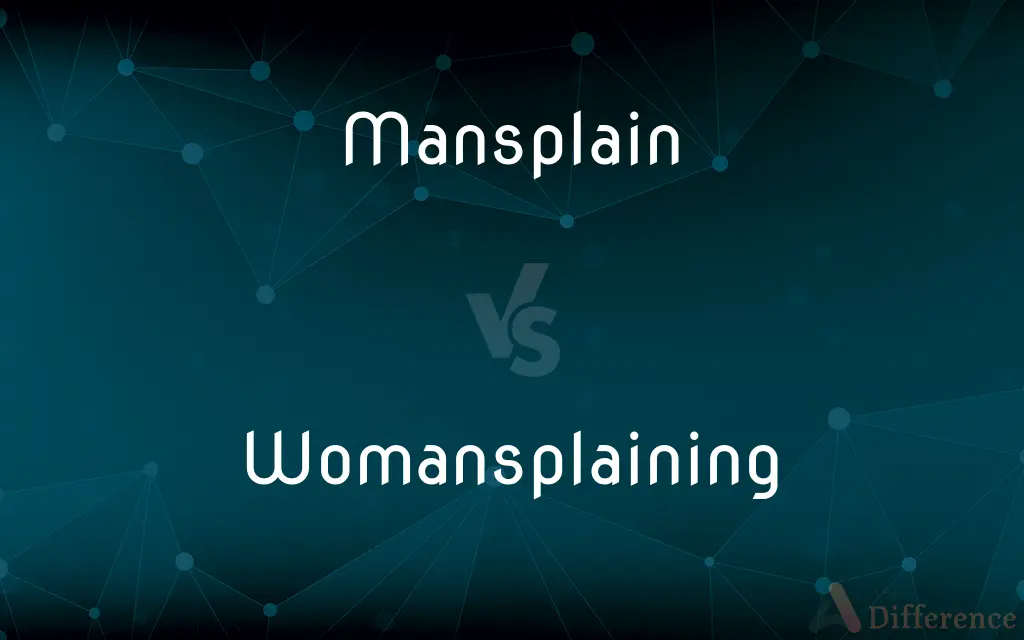Mansplain vs. Womansplaining — What's the Difference?
By Fiza Rafique & Maham Liaqat — Updated on April 1, 2024
Mansplaining refers to when a man explains something to someone, typically a woman, in a manner regarded as condescending or patronizing, whereas womansplaining is a less commonly used term that refers to a similar behavior exhibited by women.

Difference Between Mansplain and Womansplaining
Table of Contents
ADVERTISEMENT
Key Differences
Mansplaining involves a man explaining something to someone, often a woman, in a condescending manner, implying the listener's ignorance, even when the listener may know more about the subject. The term womansplaining, though less frequently used and recognized, suggests a parallel behavior where a woman may explain something to someone, possibly a man, in a patronizing or oversimplified way.
The concept of mansplaining highlights gender dynamics and power imbalances, where men might assume they possess more knowledge or authority on a subject by virtue of their gender. Womansplaining, by contrast, has emerged in discourse largely as a response or counterpart to mansplaining, suggesting that similar condescending explanations can also come from women.
Critics of the term mansplaining argue that it can be used to dismiss or undermine men's contributions to discussions, while discussions around womansplaining are less prevalent and often arise in the context of debates about gender and equality.
The use of both terms can spark discussions about communication styles, respect, and the importance of recognizing expertise and experience over gender-based assumptions.
Comparison Chart
Definition
A man explaining something to someone, typically a woman, in a condescending or patronizing manner.
A woman explaining something to someone, possibly a man, in a patronizing or oversimplified way.
ADVERTISEMENT
Common Usage
Widely recognized and discussed in feminist literature and social commentary.
Less commonly used and recognized, often mentioned in debates about gender and communication.
Implied Dynamics
Highlights gender dynamics and power imbalances, suggesting men might assume superiority in knowledge.
Suggests that similar condescending behavior can be exhibited by women, though less theorized in gender studies.
Criticism
Can be seen as dismissing or undermining men’s contributions to discussions.
Discussions around womansplaining are less prevalent, and it is often brought up in gender equality debates.
Compare with Definitions
Mansplain
Widely discussed in feminism.
Mansplaining has been extensively analyzed in feminist discourse as an example of gendered communication.
Womansplaining
Less commonly used term.
Womansplaining is not as widely recognized or discussed as mansplaining.
Mansplain
Condescending explanation.
He began to mansplain her own research topic to her, assuming she was less knowledgeable.
Womansplaining
Parallel behavior by women.
She was accused of womansplaining when she overly simplified her explanation to him.
Mansplain
Implies listener's ignorance.
Despite her expertise, he mansplained the basics of the subject to her.
Womansplaining
Emerges in gender debates.
Womansplaining comes up in discussions about whether similar behaviors are seen across genders.
Mansplain
Highlights gender dynamics.
Mansplaining often reveals underlying gender biases and assumptions about authority.
Womansplaining
Response to mansplaining.
The term womansplaining was coined as a counterpart to address similar behaviors exhibited by women.
Mansplain
Criticism of the term.
Some argue that the term mansplaining can unfairly silence men's perspectives in discussions.
Womansplaining
Focus on communication style.
Womansplaining, like mansplaining, raises questions about patronizing explanations.
Mansplain
To explain (something) condescendingly (to a female listener), especially to explain something the listener already knows, presuming that she has an inferior understanding of it merely because she is female.
Womansplaining
Condescending explanation of something by a woman, particularly to a man.
Womansplaining
Present participle of womansplain
Common Curiosities
Is womansplaining as widely recognized as mansplaining?
No, womansplaining is less commonly used and recognized, and it is not as extensively discussed in feminist literature or gender studies.
Can mansplaining be directed towards men?
While mansplaining typically involves a man explaining to a woman, it can also occur when a man condescendingly explains something to another man, especially in contexts where gender biases are at play.
What is mansplaining?
Mansplaining is when a man explains something to someone, typically a woman, in a way that is condescending or patronizing.
What is womansplaining?
Womansplaining refers to a similar condescending or patronizing explanation, but it is a behavior exhibited by women.
Does the concept of womansplaining imply that only women exhibit condescending behavior?
No, womansplaining does not imply that only women can be condescending. Instead, it suggests that similar behaviors can be exhibited by women, much like mansplaining does for men.
How do mansplaining and womansplaining impact conversations?
Both can negatively impact conversations by undermining the listener's knowledge or expertise and introducing unnecessary power dynamics.
How can one avoid mansplaining or womansplaining?
Being mindful of the listener's knowledge, experience, and expertise, and engaging in respectful and equal communication can help avoid these behaviors.
Why is mansplaining criticized?
Mansplaining is criticized because it reflects gender biases and power imbalances, often undermining the expertise or knowledge of the listener.
Are there criticisms of the term womansplaining?
Discussions around womansplaining can sometimes be controversial, as it is seen by some as a reaction to the critique of mansplaining, rather than a standalone concept reflecting gender dynamics.
Is there a positive use for the terms mansplaining and womansplaining?
While often viewed negatively, these terms can foster awareness and discussion about communication styles and gender biases, encouraging more respectful interactions.
Share Your Discovery

Previous Comparison
Savant vs. Scholar
Next Comparison
Nectar vs. PollenAuthor Spotlight
Written by
Fiza RafiqueFiza Rafique is a skilled content writer at AskDifference.com, where she meticulously refines and enhances written pieces. Drawing from her vast editorial expertise, Fiza ensures clarity, accuracy, and precision in every article. Passionate about language, she continually seeks to elevate the quality of content for readers worldwide.
Co-written by
Maham Liaqat













































